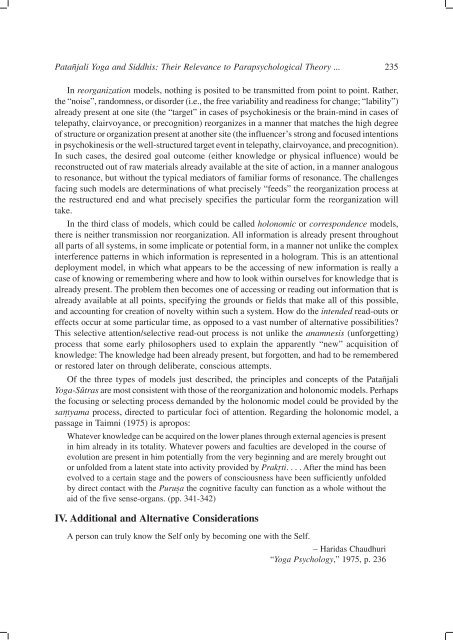Patañjali Yoga and Siddhis - Inclusive Psychology
Patañjali Yoga and Siddhis - Inclusive Psychology
Patañjali Yoga and Siddhis - Inclusive Psychology
Create successful ePaper yourself
Turn your PDF publications into a flip-book with our unique Google optimized e-Paper software.
<strong>Patañjali</strong> <strong>Yoga</strong> <strong>and</strong> <strong>Siddhis</strong>: Their Relevance to Parapsychological Theory ... 235<br />
In reorganization models, nothing is posited to be transmitted from point to point. Rather,<br />
the “noise”, r<strong>and</strong>omness, or disorder (i.e., the free variability <strong>and</strong> readiness for change; “lability”)<br />
already present at one site (the “target” in cases of psychokinesis or the brain-mind in cases of<br />
telepathy, clairvoyance, or precognition) reorganizes in a manner that matches the high degree<br />
of structure or organization present at another site (the influencer’s strong <strong>and</strong> focused intentions<br />
in psychokinesis or the well-structured target event in telepathy, clairvoyance, <strong>and</strong> precognition).<br />
In such cases, the desired goal outcome (either knowledge or physical influence) would be<br />
reconstructed out of raw materials already available at the site of action, in a manner analogous<br />
to resonance, but without the typical mediators of familiar forms of resonance. The challenges<br />
facing such models are determinations of what precisely “feeds” the reorganization process at<br />
the restructured end <strong>and</strong> what precisely specifies the particular form the reorganization will<br />
take.<br />
In the third class of models, which could be called holonomic or correspondence models,<br />
there is neither transmission nor reorganization. All information is already present throughout<br />
all parts of all systems, in some implicate or potential form, in a manner not unlike the complex<br />
interference patterns in which information is represented in a hologram. This is an attentional<br />
deployment model, in which what appears to be the accessing of new information is really a<br />
case of knowing or remembering where <strong>and</strong> how to look within ourselves for knowledge that is<br />
already present. The problem then becomes one of accessing or reading out information that is<br />
already available at all points, specifying the grounds or fields that make all of this possible,<br />
<strong>and</strong> accounting for creation of novelty within such a system. How do the intended read-outs or<br />
effects occur at some particular time, as opposed to a vast number of alternative possibilities?<br />
This selective attention/selective read-out process is not unlike the anamnesis (unforgetting)<br />
process that some early philosophers used to explain the apparently “new” acquisition of<br />
knowledge: The knowledge had been already present, but forgotten, <strong>and</strong> had to be remembered<br />
or restored later on through deliberate, conscious attempts.<br />
Of the three types of models just described, the principles <strong>and</strong> concepts of the <strong>Patañjali</strong><br />
<strong>Yoga</strong>-Sûtras are most consistent with those of the reorganization <strong>and</strong> holonomic models. Perhaps<br />
the focusing or selecting process dem<strong>and</strong>ed by the holonomic model could be provided by the<br />
sa√yama process, directed to particular foci of attention. Regarding the holonomic model, a<br />
passage in Taimni (1975) is apropos:<br />
Whatever knowledge can be acquired on the lower planes through external agencies is present<br />
in him already in its totality. Whatever powers <strong>and</strong> faculties are developed in the course of<br />
evolution are present in him potentially from the very beginning <strong>and</strong> are merely brought out<br />
or unfolded from a latent state into activity provided by Prakæti. . . . After the mind has been<br />
evolved to a certain stage <strong>and</strong> the powers of consciousness have been sufficiently unfolded<br />
by direct contact with the Purua the cognitive faculty can function as a whole without the<br />
aid of the five sense-organs. (pp. 341-342)<br />
IV. Additional <strong>and</strong> Alternative Considerations<br />
A person can truly know the Self only by becoming one with the Self.<br />
– Haridas Chaudhuri<br />
“<strong>Yoga</strong> <strong>Psychology</strong>,” 1975, p. 236






